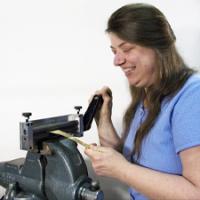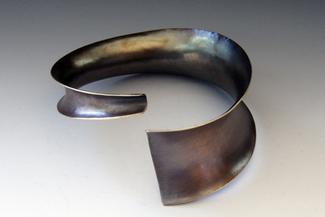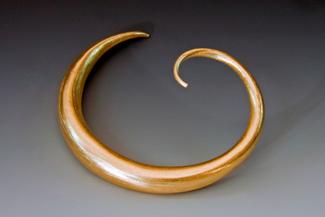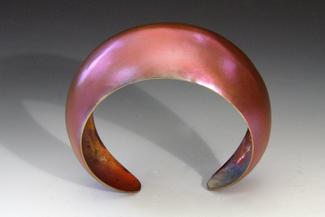Creative Metal Forming
Forming makes metal strong and flexible -- ideal for jewelry, flatware, and vessels. This workshop will explore the infinite possibilities of synclastic forming, anticlastic forming, and spiculums, while ensuring students learn to hammer comfortably and with control. These techniques allow us to create complex three-dimensional structures from a single sheet of metal. Beginning with any shape (oval, rectangle, or freeform), seamlessly combine concave and convex curves to transform a flat piece of metal into elegant fluidity.
The class will be working on a jewelry scale during this workshop to save time, but these techniques also apply to larger scale objects or sculptures. Synclasting can create domes for brooches, bracelets, bowls, and more. Anticlasting can be used to create open forms for jewelry or sculpture, as well as spiculums (A spiculum is a tube that has varying diameters). After each demonstration, participants may choose to practice on samples, or to work towards finished pieces. Students with previous experience may choose to work on more advanced, complex designs. Hammers and stakes will be available for students to use during the workshop, and available for purchase.
Cynthia Eid has been hammering and forming metal for over 40 years. She has co-written a book, Creative Metal Forming, with Betty Helen Longhi. Michael Good wrote the forward; the publisher is Tim McCreight's Brynmorgen Press. If you'd like to see more of Cynthia's work, please visit her website www.cynthiaeid.com
This class is appropriate for students with basic metalsmithing skills as well as professionals.
Meet the instructor

Whether using hammers and stakes, or hydraulic press tools, Cynthia's sculptural jewelry and hollowware shows her focus on exploring the fluidity with which metal can be moved, formed, and joined.
Cynthia Eid co-authored the book Creative Metal Forming, with Betty Helen Longhi, published in 2013 by Tim McCreight's Brynmorgen Press. In his foreword for the book, Michael Good says the authors "have succeeded in assembling the first comprehensive textbook on synclastic and anticlastic forming." (More about the book available at www.creativemetalforming.com.)
Cynthia and Betty developed a set of anticlastic stakes, and Eid also works with Knew Concepts and Bonny Doon to help make tools for jewelers and metalsmiths. Lee Marshall has dubbed Cynthia Eid "Godmother of the Knew Concept Saws" since it was her idea for him to produce these saws for jewelers.
Excited about working in sterling silver without the problem of firescale, Cynthia has been working with Argentium Silver since 1999. After meeting Peter Johns (the inventor of Argentium Silver) in 2003, Eid has participated in AS's development. Argentium International, Ltd recognizes her as a Pioneer.
Cynthia Eid's metalwork has won awards for creativity and design, been featured in many publications, and been exhibited internationally. With a BS in Art Education and MFA in Jewelry, Design, and Silversmithing, she has previously worked as a bench jeweler for fine goldsmiths, a model-maker in a gold jewelry factory, and on private commissions. Her work is in museums in the US and UK. Currently an independent metalsmith and educator, she teaches weekly classes at Metalwerx in Massachusetts, and workshops and short courses in the US, Canada, Europe, and Australia.
Materials & Tools
There is a materials fee for this class, estimated at $40, which is payable to instructor at workshop. Kit contents include:
- Nugold 24 gauge- 6" x 12"
- 20 gauge 6" x 6"
- pine blocks for synclastic forming
- rental fee for tool kit
The instructor will have additional metal available for purchase as needed.
- Any hammers, mallets and anticlastic stakes you already own (plastic, wood, or steel). Tools will be provided for use during workshop, and are available for purchase, so do not worry if you do not own any. By bringing what you have, it will be easier to know if what you already own works for these techniques.
- A Basic tool kit Please note: Metalwerx has hand tools available for student use, but you might have to share. Students may wish to bring their own tool kit. Useful items to bring include:
- paper, pencil, fine tipped permanent marker (e.g. Sharpie)
- Abrasive paper, sanding sticks, files
- Jeweler's saw, saw blades
- Pliers, such as flat, round nose, chain nose....flat/half-round and Flat/round
- A shop towel or two---this can be a hand towel, or larger-- to save on paper towels, wrap work up in, etc.
- Closed toed footwear is mandatory in the studio (Hot, sharp and/or heavy things tend to be dropped onto toes)
- Additional items that students might find useful, and may wish to bring:
- If you know that you tend to work large, or prolifically, you may wish to bring extra metal in the gauges listed above.
- Students may bring Argentium Sterling or traditional sterling silver to work in if they wish to work in silver. Fine silver can be good for small jewelry or if it is to be enameled.
- Apron
- Rubber bands or barrettes to keep long hair away from flames and machinery
- Can be handy: tracing paper, graph paper, carbon paper
- Any of your favorite tools that are not listed
- Items that will be available for people to use and to purchase:
- Hammers
- Stakes
- Joyce Chen shears
If you are flying to the workshop:
We suggest packing tools and non-precious metals in a toolbox or suitcase that is checked, and place a note on top describing why you are flying with the tools. Pack in see-through plastic bags or boxes to make it easier for TSA to see things without making a mess. It can be helpful to include a printout from the website about the workshop.



